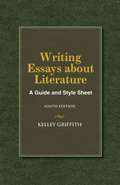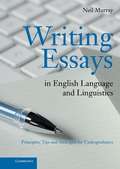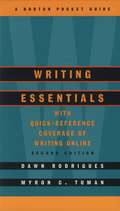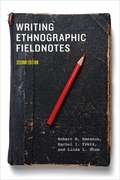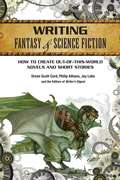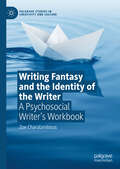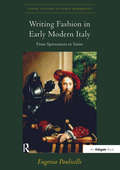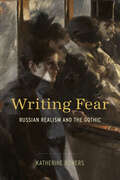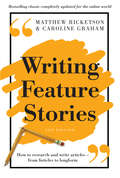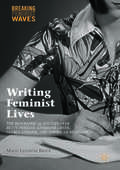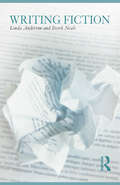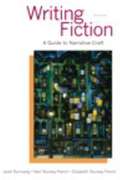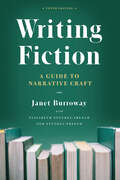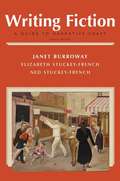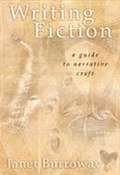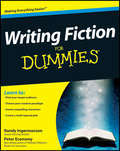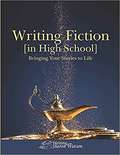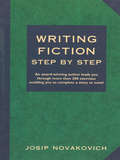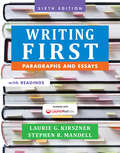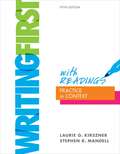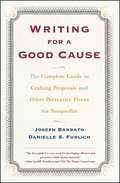- Table View
- List View
Writing Essays About Literature
by Kelley GriffithWidely used in introductory literature courses as a style guide or as a supplement to anthologies, this book provides valuable guidelines for interpreting literature and writing essays. It includes full-length selections as well as essays.
Writing Essays in English Language and Linguistics
by Neil MurrayEnglish language and linguistics shares many of its writing conventions with those of other disciplines, but there are certain features and expectations that distinguish it as a subject. This book is written specifically to help undergraduate students of English language and linguistics develop the art of writing essays, projects and reports. Written by an author with over 30 years' experience of lecturing in the subject, it is a comprehensive and very readable resource and contains numerous discipline-related examples, practice exercises and an answer key. It includes chapters on referencing (including plagiarism, paraphrase and guidance on referencing styles), stylistic issues that often get overlooked, and writing a dissertation. The book offers practical guidance and a layout that guides students as they work though their project. It will be an invaluable reference tool that students can read cover to cover or dip into as and when required.
Writing Essentials
by Sandra Panman Richard PanmanThis book teaches students the kind of writing required for school assignments, written exams, and the workplace. It consists of twelve chapters grouped into three major sections. The first part of the book teaches how to write resumes and business letters. The second section focuses on writing essays using four of the major writing strategies: narration, description, exposition, and persuasion. The last part guides students through writing book reports, short reports, and research papers.
Writing Essentials: A Norton Pocket Guide
by Dawn Rodriguez Myron C. TumanWriting Essentials combines the essentials of grammar, punctuation, mechanics, and documentation with practical suggestions for writing online.<P> From online prewriting, drafting, group workshopping, revising, and editing, to database searching, navigating the Internet, documenting online sources, and designing documents, Writing Essentials offers practical, hands-on advice for using computers throughout the writing process.
Writing Ethnographic Fieldnotes
by Robert M. Emerson Rachel I. Fretz Linda L. ShawIn "Writing Ethnographic Fieldnotes, "Robert M. Emerson, Rachel I. Fretz, and Linda L. Shaw present a series of guidelines, suggestions, and practical advice for creating useful fieldnotes in a variety of settings, demystifying a process that is often assumed to be intuitive and impossible to teach. Using actual unfinished notes as examples, the authors illustrate options for composing, reviewing, and working fieldnotes into finished texts. They discuss different organizational and descriptive strategies and show how transforming direct observations into vivid descriptions results not simply from good memory but from learning to envision scenes as written. A good ethnographer, they demonstrate, must learn to remember dialogue and movement like an actor, to see colors and shapes like a painter, and to sense moods and rhythms like a poet. This new edition reflects the extensive feedback the authors have received from students and instructors since the first edition was published in 1995. As a result, they have updated the race, class, and gender section, created new sections on coding programs and revising first drafts, and provided new examples of working notes.
Writing Ethnographic Fieldnotes, Second Edition
by Emerson Robert M. Fretz Rachel I. Shaw Linda L.In Writing Ethnographic Fieldnotes, Robert M. Emerson, Rachel I. Fretz, and Linda L. Shaw present a series of guidelines, suggestions, and practical advice for creating useful fieldnotes in a variety of settings, demystifying a process that is often assumed to be intuitive and impossible to teach. Using actual unfinished notes as examples, the authors illustrate options for composing, reviewing, and working fieldnotes into finished texts. They discuss different organizational and descriptive strategies and show how transforming direct observations into vivid descriptions results not simply from good memory but from learning to envision scenes as written. A good ethnographer, they demonstrate, must learn to remember dialogue and movement like an actor, to see colors and shapes like a painter, and to sense moods and rhythms like a poet. This new edition reflects the extensive feedback the authors have received from students and instructors since the first edition was published in 1995. As a result, they have updated the race, class, and gender section, created new sections on coding programs and revising first drafts, and provided new examples of working notes. An essential tool for budding social scientists, the second edition of Writing Ethnographic Fieldnotes will be invaluable for a new generation of researchers entering the field.
Writing Fantasy And Science Fiction: How To Create Out-of-this-world Novels And Short Stories
by Orson Scott Card Writer's Digest Books Editors Philip Athans Jay LakeCraft an otherworldly experience for your readers! Do you envision celestial cities in distant, fantastic worlds? Do you dream of mythical beasts and gallant quests in exotic kingdoms? If you have ever wanted to write the next great fantasy or science fiction story, this all-in-one comprehensive book will show you how. Writing Fantasy & Science Fiction is full of advice from master authors offering definitive instructions on world building, character creation, and storytelling in the many styles and possibilities available to writers of speculative fiction.
Writing Fantasy and the Identity of the Writer: A Psychosocial Writer’s Workbook (Palgrave Studies in Creativity and Culture)
by Zoe CharalambousThis book presents the innovative pedagogy of Writing Fantasy: a method for exploring and shifting one’s identity as a writer. The book draws on qualitative research with undergraduate creative writing students and fills a gap in the literature exploring creative writing pedagogy and creative writing exercises. Based on the potential to shift writer identity through creative writing exercises and the common ground that these share with the stance of the Lacanian analyst, the author provides a set of guidelines, exercises and case studies to trace writing fantasy, evidenced in one’s creative writing texts and responses about creative writing. This innovative work offers fresh insights for scholars of creativity, Lacan and psychosocial studies, and a valuable new resource for students and teachers of creative writing.
Writing Fashion in Early Modern Italy: From Sprezzatura to Satire (Visual Culture in Early Modernity)
by Eugenia PaulicelliThe first comprehensive study on the role of Italian fashion and Italian literature, this book analyzes clothing and fashion as described and represented in literary texts and costume books in the Italy of the 16th and 17th centuries. Writing Fashion in Early Modern Italy emphasizes the centrality of Italian literature and culture for understanding modern theories of fashion and gauging its impact in the shaping of codes of civility and taste in Europe and the West. Using literature to uncover what has been called the ’animatedness of clothing,’ author Eugenia Paulicelli explores the political meanings that clothing produces in public space. At the core of the book is the idea that the texts examined here act as maps that, first, pinpoint the establishment of fashion as a social institution of modernity; and, second, gauge the meaning of clothing at a personal and a political level. As well as Castiglione’s The Book of the Courtier and Cesare Vecellio’s The Clothing of the Renaissance World, the author looks at works by Italian writers whose books are not yet available in English translation, such as those by Giacomo Franco, Arcangela Tarabotti, and Agostino Lampugnani. Paying particular attention to literature and the relevance of clothing in the shaping of codes of civility and style, this volume complements the existing and important works on Italian fashion and material culture in the Renaissance. It makes the case for the centrality of Italian literature and the interconnectedness of texts from a variety of genres for an understanding of the history of Italian style, and serves to contextualize the debate on dress in other European literatures.
Writing Fear: Russian Realism and the Gothic
by Katherine BowersIn Russia, gothic fiction is often seen as an aside – a literary curiosity that experienced a brief heyday and then disappeared. In fact, its legacy is much more enduring, persisting within later Russian literary movements. Writing Fear explores Russian literature’s engagement with the gothic by analysing the practices of borrowing and adaptation. Katherine Bowers shows how these practices shaped literary realism from its romantic beginnings through the big novels of the 1860s and 1870s to its transformation during the modernist period. Bowers traces the development of gothic realism with an emphasis on the affective power of fear. She then investigates the hybrid genre’s function in a series of case studies focused on literary texts that address social and political issues such as urban life, the woman question, revolutionary terrorism, and the decline of the family. By mapping the myriad ways political and cultural anxiety take shape via the gothic mode in the age of realism, Writing Fear challenges the conventional literary history of nineteenth-century Russia.
Writing Feature Articles
by Brendan HennessyHennessy's classic text tells you everything you need to know about writing successful features. You will learn how to formulate and develop ideas and how to shape them to fit different markets. Now in its fourth edition, Writing Feature Articles has been fully revised and updated to take into account the changing requirements of journalism and media courses. You will also discover how to exploit new technology for both researching and writing online.Learn step-by-step how to plan, research and write articles for a wide variety of 'popular', 'quality' and specialist publications. Discover more and make the advice stick by completing the tasks and reading the keen analysis of extracts from the best of today's writing.Packed with inspirational advice in a friendly, highly readable style, this guide is a must-have for practising and aspiring journalists and writers.
Writing Feature Stories: How to research and write articles - from listicles to longform
by Matthew Ricketson Caroline GrahamGood writing engages as it informs and feature journalism offers writers the opportunity to tell deep, affecting stories that look beyond the immediate mechanics of who, what, where and when and explore the more difficult-and more rewarding- questions: how and why? Whether you're a blogger, a news journalist or an aspiring lifestyle reporter, a strong voice and a fresh, informed perspective remain in short supply and strong demand; this book will help you craft the kind of narratives people can't wait to share on their social media feeds.Writing Feature Stories established a reputation as a comprehensive, thought-provoking and engaging introduction to researching and writing feature stories. This second edition is completely overhauled to reflect the range of print and digital feature formats, and the variety of online, mobile and traditional media in which they appear.This hands-on guide explains how to generate fresh ideas; research online and offline; make the most of interviews; sift and sort raw material; structure and write the story; edit and proofread your work; find the best platform for your story; and pitch your work to editors.'A wide-ranging, much-needed master class for anyone who tells true yarns in this fast-changing journalistic marketplace' - Bruce Shapiro, Columbia University'Useful and thought provoking' - Margaret Simons, journalist and author'A must read for any digital storyteller who wants to write emotive, engaging, believable content.' - Nidhi Dutt, foreign correspondent
Writing Feminist Lives
by Malin Lidström BrockThis book draws attention to the controversy that surrounds Betty Friedan, Germaine Greer, Gloria Steinem, and Simone de Beauvoir's lives and the important role that their life stories have played in their feminist writing. Directly and indirectly, the four women have contributed to battles over feminism's meaning through autobiographically informed political writing. Inevitably, therefore, their biographers are also participants in these battles, yet not always on the same side as their subjects. Writing Feminist Lives introduces a further fold of nuance into considerations of biography and feminism by showing that the biographers of the four women have made methodological choices that reflect their loyalty to, or their scepticism towards, competing ideological definitions of the exemplary feminist life.
Writing Fiction
by Linda Anderson Derek NealeWriting Fiction offers the novice writer engaging and creative activities, making use of insightful, relevant readings from well-known authors to illustrate the techniques presented. This volume makes use of new versions of key chapters from the recent Routledge/Open University textbook Creative Writing: A Workbook with Readings for writers who are specializing in fiction. Using their experience and expertise as teachers as well as authors, Linda Anderson and Derek Neale guide aspiring writers through such key aspects of writing as: how to stimulate creativity keeping a writer’s notebook character creation setting point of view structure showing and telling. The volume is further updated to include never-before published interviews with successful fiction writers Andrew Cowan, Stevie Davies, Maggie Gee, Andrew Greig, and Hanif Kureishi. Concise and practical, Writing Fiction offers an inspirational guide to the methods and techniques of authorship and is a must-read for aspiring writers.
Writing Fiction: A Guide to Narrative Craft (Ninth Edition)
by Janet Burroway Elizabeth Stuckey-French Ned Stuckey-FrenchIt explores the elements of fiction, providing practical writing techniques and concrete examples, that is personal and non-prescriptive, the text encourages students to develop proficiency through each step of the writing process, offering an abundance of exercises designed to spur writing and creativity, integrates diverse, contemporary short stories in the reading of inspiring fiction goes hand-in-hand with the writing of fresh and exciting stories.
Writing Fiction: A Guide to Narrative Craft (Chicago Guides to Writing, Editing, and Publishing)
by Janet Burroway Elizabeth Stuckey-French Ned Stuckey-FrenchThis updated edition of the classic, comprehensive guide to creative writing features new topics and writing prompts, contemporary examples, and more.A creative writer’s shelf should hold at least three essential books: a dictionary, a style guide, and Janet Burroway’s Writing Fiction. This best-selling classic is the most widely used creative writing text in America, and for decades it has helped hundreds of thousands of students learn the craft. Now in its tenth edition, Writing Fiction is more accessible than ever for writers of all levels—inside or outside the classroom.This new edition continues to provide advice that is practical, comprehensive, and flexible. Moving from freewriting to final revision, Burroway addresses “showing not telling,” characterization, dialogue, atmosphere, plot, imagery, and point of view. It includes new topics and writing prompts, and each chapter now ends with a list of recommended readings that exemplify the craft elements discussed. Plus, examples and quotations throughout the book feature a wide range of today’s best and best-known creators of both novels and short stories.
Writing Fiction: A Guide to Narrative Craft (8th Edition)
by Janet Burroway Elizabeth Stuckey-French Ned Stuckey-French'Writing Fiction' explores the elements of fiction, providing practical writing techniques and examples. This book encourages students to develop proficiency through each step of the writing process. It also integrates diverse, contemporary short stories in every chapter.
Writing Fiction: A Guide to Narrative Craft
by Janet Burroway Susan WeinbergThe most widely used and respected book on writing fiction, Writing Fiction guides the writer from first inspiration to final revision. Supported by an abundance exercises, this guide/anthology explores and integrates the elements of fiction while offering practical techniques and concrete examples. A focus on the writing process in its entirety provides a comprehensive guide to writing fiction, approaching distinct elements in separate chapters while building on what has been covered earlier. Topics include free-writing to revision, plot, style, characterization, dialogue, atmosphere, imagery, and point of view. An anthology of diverse and contemporary short stories followed by suggestions for discussion and writing exercises, illustrates concepts while offering variety in pacing and exposure to this increasingly popular form. The book also discusses key issues including writing workshops, using autobiography as a basis for fiction, using action in stories, using dialogue, and maintaining point of view. The sixth edition also features more short short stories than any previous edition and includes quotation boxes that offer advice and inspirational words from established writers on a wide range of topics--such as writing from experience, story structure, openings and endings, and revision. For those interested in developing their creative writing skills.
Writing Fiction
by Randy Ingermanson Peter EconomyA complete guide to writing and selling your novel So you want to write a novel? Great! That's a worthy goal, no matter what your reason. But don't settle for just writing a novel. Aim high. Write a novel that you intend to sell to a publisher. Writing Fiction for Dummies is a complete guide designed to coach you every step along the path from beginning writer to royalty-earning author. Here are some things you'll learn in Writing Fiction for Dummies: Strategic Planning: Pinpoint where you are on the roadmap to publication; discover what every reader desperately wants from a story; home in on a marketable category; choose from among the four most common creative styles; and learn the self-management methods of professional writers. Writing Powerful Fiction: Construct a story world that rings true; create believable, unpredictable characters; build a strong plot with all six layers of complexity of a modern novel; and infuse it all with a strong theme. Self-Editing Your Novel: Psychoanalyze your characters to bring them fully to life; edit your story structure from the top down; fix broken scenes; and polish your action and dialogue. Finding An Agent and Getting Published: Write a query letter, a synopsis, and a proposal; pitch your work to agents and editors without fear. Writing Fiction For Dummies takes you from being a writer to being an author. It can happen-if you have the talent and persistence to do what you need to do.
Writing Fiction [in High School]: Bringing Your Stories To Life!
by Sharon WatsonDoes your teen love to write stories? Does he or she want to be a positive Christian influence in the world through fiction? WRITING FICTION [IN HIGH SCHOOL] is written to the student in a conversational tone and requires only minimal parental/teacher guidance. It's packed with literally hundreds of age-appropriate, real-fiction examples from classics, best-sellers, and movies so students can learn how to write their own intriguing short stories or novels. Your students will study and practice essential elements of story writing: an empathetic protagonist, effective dialog, voice, characterization, scenes, plots, the hero's journey, and much more. In addition, they'll discuss important ideas about fiction in their groups formed from class members, co-op classes, or friends. WRITING FICTION [IN HIGH SCHOOL] refers to The Last Book in the Universe by Rodman Philbrick (sold separately) in many of its chapters. Sharon Watson recommends purchasing that book and using it with the textbook so students can more easily see how a complete novel and its elements work. An optional manuscript track is included in the course; this way, students who have written a short story or novel manuscript can work on it. Prerequisites: none. Be sure to grab WRITING FICTION [IN HIGH SCHOOL] : TEACHER'S GUIDE, a practical guide that contains an answer key, along with books or movies needed for each chapter. WRITING FICTION [IN HIGH SCHOOL] is written by Sharon Watson, author of the popular middle school composition curriculum JUMP IN, and is specially designed for your homeschool, private school, or Christian teen. THE NEW VERSION IS COMPATIBLE WITH THE ORIGINAL VERSION.
Writing Fiction Step by Step: An Award-Winning Author Leads You Through More than 200 Exercises Enabling You to Complete a Story or Novel
by Josip NovakovichWriting Fiction Step by Step gives you more than 200 exercises that will sharpen your writing skills while helping you develop complete short stories, even novels. In this sequel to his very popular Fiction Writer's Workshop, Whiting Award-winning author Josip Novakovich shows you that writing fiction is about making connections–between character and plot, setting and conflict, memory and imagination. You'll make these connections by linking the exercises. A character invented in chapter two can appear in a scene outlined in chapter eight and can speak in a voice developed in chapter ten. Embark on a unique writing journey and learn step by step how to craft fiction that captivates readers.
Writing First with Readings
by Laurie G. Kirszner Stephen R. MandellBest-selling authors and veteran college writing instructors Laurie Kirszner and Stephen Mandell believe that students learn to write best when they use their own writing as a starting point. In Writing First with Readings: Paragraphs and Essays, the authors take a simple yet effective approach to helping students improve their writing skills: visual writing prompts open every chapter and get students writing immediately. Then, throughout the chapter, students move between their own writing, writing models and instruction, and workbook-style mastery exercises so that they continually revise, rewrite, and improve their own writing. It is this formula that makes writing instruction meaningful and accessible for students. Thoughtful chapters on academic writing and success, research, and critical reading, along with high-interest essays, round out this new edition, making it the perfect introduction to college writing.
Writing First With Readings: Practice In Context
by Laurie G. Kirszner Stephen R. MandellBest-selling authors and veteran college writing instructors Laurie Kirszner and Stephen Mandell believe that students learn to write best when they use their own writing as a starting point. In Writing First with Readings: Practice in Context, designed for the paragraph to essay course, Kirszner and Mandell take seriously the ideas and expressive abilities of developmental students, as well as their need to learn the rules of writing and grammar. Visual writing prompts that open every chapter get students writing immediately. By moving frequently between their own writing, writing models and instruction, and workbook-style mastery exercises, students get constant reinforcement of the skills they are learning. Thoughtful chapters on college success, research, and critical reading, along with high-interest essays, round out the text, making it the perfect introduction to college writing.
Writing For a Good Cause
by Joseph Barbato Danielle FurlichFilled with tips and survival skills from writers and fund-raising officers at nonprofits of all sizes, Writing for a Good Cause is the first book to explain how to use words well to win your cause the money it needs. Whether you work for a storefront social action agency or a leading university, the authors' knowledgeable, practical advice will help you: Write the perfect proposal -- from the initial research and interviews to the final product Draft, revise, and polish a "beguiling, exciting, can't-put-it-down and surely can't-turn-it-down" request for funds Create case statements and other big money materials -- also write, design, and print newsletters, and use the World Wide Web effectively Survive last-minute proposals and other crises -- with the Down-and-Dirty Proposal Kit! Writing for a Good Cause provides everything fund raisers, volunteers, staff writers, freelancers, and program directors need to know to win funds from individual, foundation, and corporate donors.
Writing for Academic Journals
by MurrayWriting for publication is a daunting and time-consuming task for many academics. And yet the pressure for academics to publish has never been greater. This book demystifies the process of writing academic papers, showing readers what good papers look like and how they can be written. Offering a research-informed understanding of the contemporary challenges of writing for publication, this book gives practical advice for overcoming common obstacles such as finding a topic, targeting journals, and finding the time to write. The author offers a range of helpful writing strategies, making this an invaluable handbook for academics at all stages of their career, from doctoral students to early career researchers and even experienced academics. The third edition has been comprehensively updated to reflect the changing landscape of academic writing, including the most recent research and theory on writing across the disciplines. Drawing on her extensive experience of running writing workshops and working closely with academics on developing writing, Rowena Murray offers practical and tested strategies for good academic writing. New to the third edition: Advice on how to use social media to promote your publications More examples from different disciplines and journals More advice on how to tackle writer's block Extended end-of-chapter checklists New evidence that these strategies really work!
